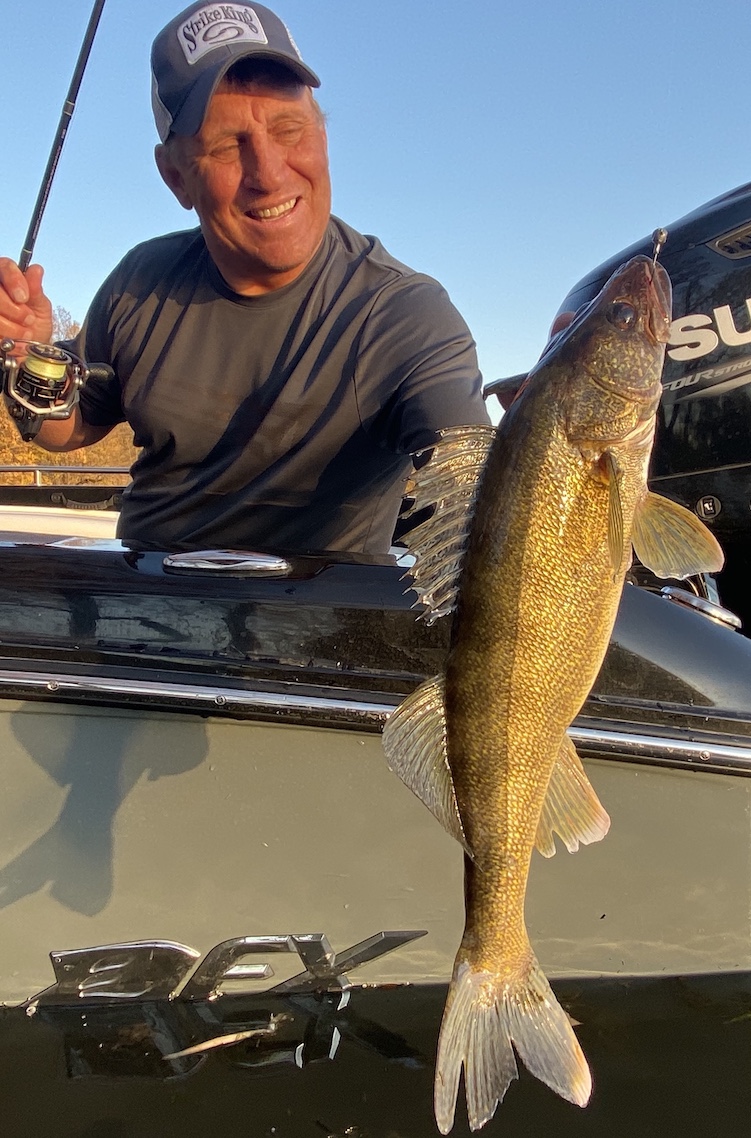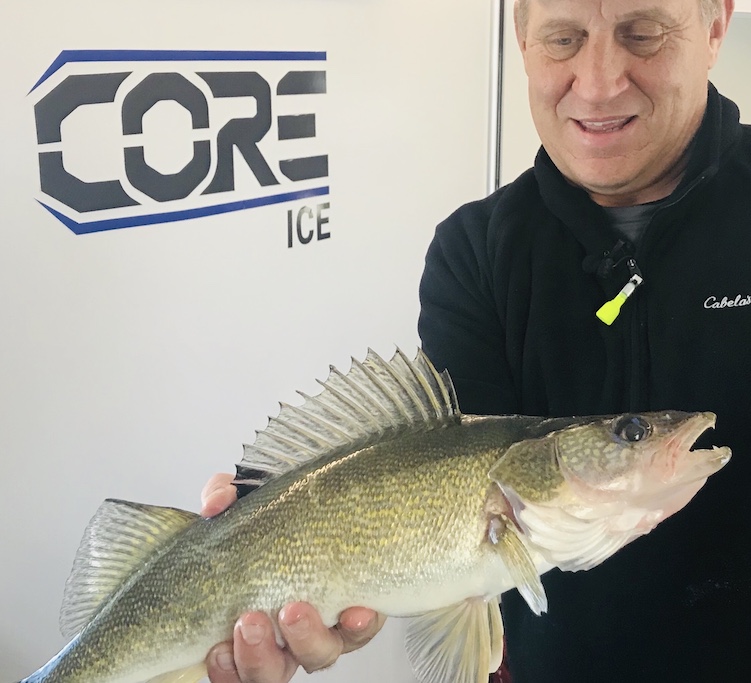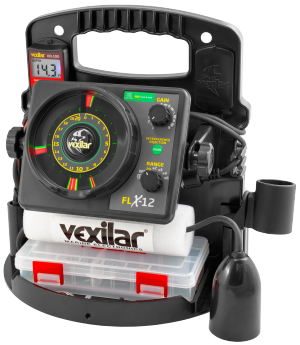News & Stories
See the bite
Posted by director on December 23, 2019
 See the bite!
See the bite!
By Mike Frisch
One of the advantages of ice fishing over open-water fishing is that bites from fish can often be “seen” better in winter than in summer! What I mean is that, since anglers fish vertically right below where they sit and on stationary platforms, monitoring baits being fished and detecting bites can be much easier. Not only does this aid in bite detection, and hopefully hooking percentage, but it is also a very enjoyable part of ice fishing. One simple device that can make bite detection even more effective is a spring bobber.
Some anglers prefer to “sight fish” where they actually look into clear water, particularly when fishing shallow water and during the day. Other anglers rely on underwater cameras, which also shine in clear water and during daytime. Most winter anglers, however, use a flasher sonar unit like a Vexilar. Flashers don’t show the actual bait and fish, but they do show “marks” on the sonar screen that represent an angler’s bait, any fish around it, and also show a mark that represents the lake bottom.
Being able to see these things not only aids in bait placement as it relates to where the fish are in the water column, but also helps an angler monitor a fish’s response to the jigging motions the angler is using. While it’s impossible to actually see the fish take the lure, sonar is very beneficial in helping anticipate bites as well.
When a fish does approach and take a lure, what then becomes important is the angler’s detection of that bite and his or her response to it. When fishing bigger lures like jigging spoons for walleyes, a sensitive, fast-action rod in a medium or medium light power is often effective for bite detection. This set-up fishes much like an open-water angler would use a “long rod” with the same characteristics to vertically jig with a jig and minnow combination. The angler mostly relies on feel to determine when a fish hits the lure and when to set the hook.
When fishing smaller, lighter baits, however, is when the venerable spring bobber, around for many years, is still very effective. The spring bobber is basically a sensitive spring extending from the rod tip that the line threads through. Some spring bobbers are actually coiled springs, while others are a single wire tip extending to the last rod guide.
Regardless the style used, when a fish bites (even the lightest of bites) the spring will bend to the bait “showing” the bite. Since panfish often “feed up” as well, some bites are seen by the spring straightening up as the fish moves up with the bait. In either case, this is a very effective way to fish light jigs, particularly for finicky-biting panfish like crappies and bluegills, and still be able to determine when a fish hits and when it’s time to set the hook!
Recently, I started fishing the Clam Matt Johnson Panfish rod with my light panfish lures. This rod has a very sensitive spring bobber tip and is made with top components like a graphite blank and premium guides. This rod is great for bite detection and does an excellent job of helping me fight and land hard-fighting panfish.
If fighting more panfish is your goal this winter, then consider using a spring bobber. Spring bobbers enable you to fish light jigs, see the fish bite, and hopefully lead to more hooked fish. Good luck on the water and, as always, remember to include a youngster in your next outdoors adventure!
Mike Frisch hosts the popular Fishing the Midwest TV series. Visit www.fishingthemidwest.com to see more from Fishing the Midwest.
Changes in fishing
Posted by director on December 23, 2019

CHANGES IN FISHING
by Bob Jensen
I’ve been in the business of fishing for about 40 years, and have been fishing even longer. The changes in fishing and fishing equipment over those years have been many, and a lot of those changes have effected, for the better, the way we fish and what we catch. Following are some of the changes that I’ve experienced.
I remember when graphite fishing rods were first introduced to anglers. The actions of the rods weren’t very good, they were a little fragile and a lot expensive. And every angler had to have one. The graphite rods that we fish with today are way better. They’re strong, we can find rods with actions that are perfect for a particular technique, and when the increase in quality and inflation are considered, the price of rods are actually less than they used to be.
Boats have changed a lot also. When I got my first boat that was to be used for business, it was aluminum and 16 feet long. It had a 50 horsepower tiller motor that put a lot of exhaust into the air. It also used a lot of gas. It had a flasher depthfinder in the back of the boat and an electric motor that I steered with my hand on the bow of the boat. When I was fishing from the bow, I moved the sonar from the back to the front. When we wanted to stay in a particular location, we put an anchor out. I couldn’t imagine a better boat for fishing then, but my powers of prediction were never very good. The boats we run today are so much better and so much easier to control. When we want to fish from a particular location, we push a button on the electric motor and it keeps us there. No more anchors to lift or get tangled in. The 150 horsepower motor of today uses less gas than the 50’s of yesteryear, and sitting behind a steering wheel is so much more comfortable on those long runs than the 50 horse motor that I started with. Of course there are lots of folks, I’m one of them, that still likes to fish from a 16 foot boat with a 50 horsepower motor. But today’s 16 with a 50 is so different, in a better way, than the 16’s with 50’s of 40 years ago.
Fishing line is superior today, and we have a lot more choices of it. We can spool on a line that is close to perfect for any technique, and it’s also much more reliable.
There’s a much wider selection of artificial baits now than 40 years ago. Sizes, colors, shapes: It’s possible to tie on a bait that seems to look livelier than the live version.
And, best of all, in many situations, the fishing is better now than it was 40 years ago, for size and numbers. Much of that is because of the improvements in the equipment that we use and the knowledge that has been shared down through the years, but it’s also due to better fisheries management. We’ve learned that all lakes can’t be managed the same way: One size does not fit all. It might be a bit confusing and kind of a nuisance to have different regulations on different bodies of water, but in many cases, not all but many, those regulations give us the opportunity to catch truly big fish more often than we used to.
I admit that I’m slow to accept change, and my computer, cell phone and sonar still do way more than I need them to do, but the changes that we’ve seen in the world of fishing in the past few decades certainly have for the most part increased our chances for success when we’re on the water.
Photo Caption—Because of changes in how we fish and what we fish with, walleyes like this one are more common than they used to be.
To see the most current and some older episodes of Fishing the Midwest television, fishing articles and fishing videos, and to enter to win a Vexilar depth-finder, go to fishingthemidwest.com
Early Ice Fishing Tips
Posted by director on December 3, 2019

Early season ice fishing tips
By Mike Frisch
The thermometer reads 8-degrees as I write this article in mid-November, meaning we will have safe ice very, very soon and that also means an early start to the ice fishing season! In fact, I anticipate being on the ice by December 1, barring some big change in weather patterns. Here is a look at some ideas that I will keep in mind for my initial trips on the ice.
Be quiet
Early ice is often clear, not very thick, and may be devoid of snow cover. Those factors mean that a quiet approach is necessary to avoid spooking fish. Particularly if you chase shallow water fish.
Early ice walleyes get most of my attention at this time and I usually prefer fishing the “golden hour,” that last hour before darkness when walleyes get active on lots of lakes. I like to get to my fishing spot well before the bite is expected so that I can drill holes, get lines set, and have all me geared organized. My goal is to be ready and quiet when those hungry early winter walleyes start to get active!
Be aggressive
Getting to a fishing spot and setting up early and then being quiet are important tips. When the fishing starts, I do like to be active with my fishing approach and that means using aggressive jigging tactics.
Mid-winter can be a great time for soaking a minnow under a bobber and waiting for lethargic fish to show some interest and hopefully eat that minnow. Now, however, I like to capitalize on a fish’s desire to eat in anticipation of the coming long winter and do that by using aggressively-fished jigging spoons to “call in” fish and trigger reactionary bites from them.
My approach starts by snapping the jigging spoon up (and allowing it to fall) aggressively several times. When a fish appears on my sonar unit, a slower shaking of the spoon and even a pause is then used to attempt to trigger the bite. If that fish is caught or moves off, it’s back to aggressive snaps in an effort to interest another fish.
See what’s up!
A more accurate way to state this tip would be to “see what’s below!” Seeing bottom, my bait, and any fish that come near it using a winter sonar unit is what’s being recommended here.
Knowing where in the water column the fish are in relation to my bait and how they are reacting to my various jigging movements helps me “trick” fish into biting. This is one of the parts of ice fishing that I find most enjoyable and also vital to success!
With the aid of winter sonar, I can determine if my bait needs to be raised or lowered and I can gauge the mood of the fish and what jigging techniques are working the best that day. The FLX-12 sonar I use has all the features I need, does a great job of showing me what’s below, and is really easy to use and interpret as well.
Ice fishing season is very near. If “seeing” and catching fish soon is on your agenda, consider using the tips offered here when heading out for your first ice trips. And, as always, remember to include a youngster in your fishing and other outdoor adventures!
Mike Frisch hosts the popular Fishing the Midwest TV series and is a co-founder of the Bass Pro Shops and Cabela’s School of Fish. Visit fishingthemidwest.com to see more from Mike and Fishing the Midwest.

